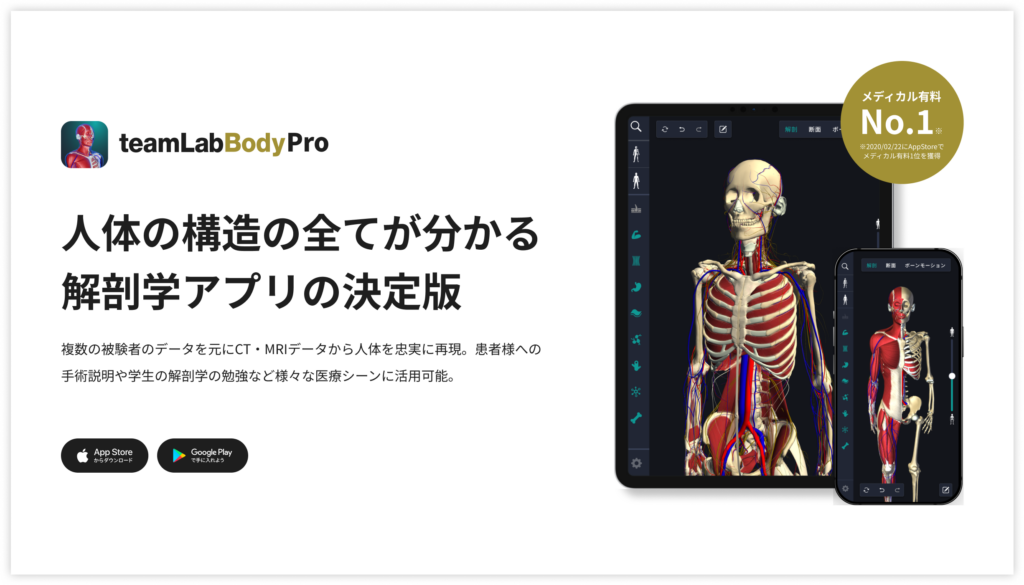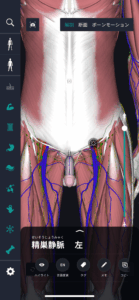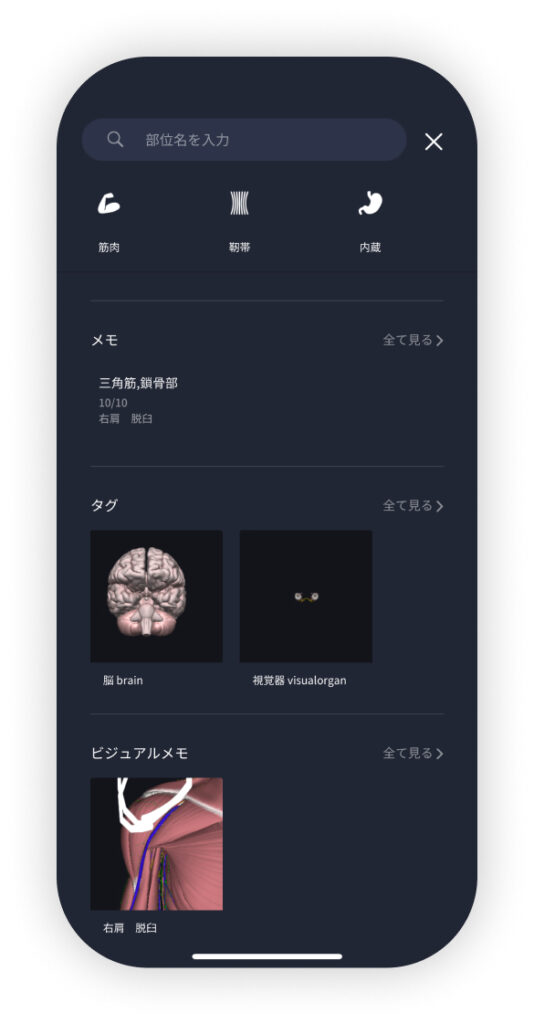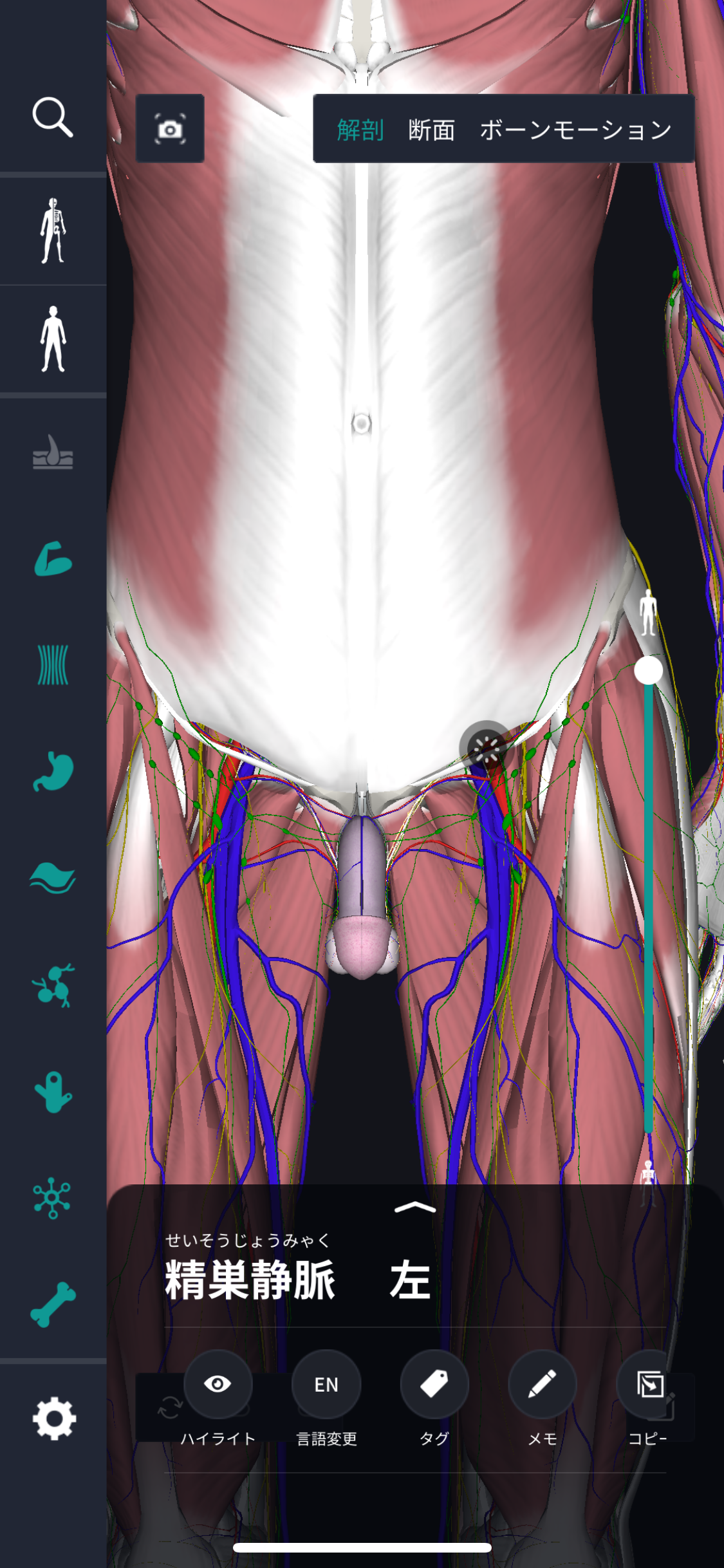beginning
In this article, I will explain effective study methods, starting with knowledge of specialized parts in human anatomy.
In human anatomy, it is necessary not only to memorize the names of various organs, muscles, and bones, but also to remember where they are located in the body. Therefore, it is necessary to learn as efficiently as possible.
I hope you can read this article and use the app to deepen your understanding even a little bit.
Now, I'll explain the details about the “testicular vein” and how to study human anatomy.
teamLab Body Pro Free Download
A 3D anatomy app that shows all the structures of the human body
Download teamLab Body Pro here!

What are testicular veins?
In the anatomy application, you can view a selection of anatomy 3D models. In this model, there are various observation methods such as surfaces, cross-sections, and nervous systems. This time, I'll explain using an anatomy application.
About testicular veins

Testicular veins are blood vessels that are mainly responsible for returning blood from the testes (testicles) to the heart. These veins play an important role in maintaining overall body health by supplying oxygen to the testes and other parts of the body and then recirculating blood containing waste products. Testicular veins are also important in regulating heat. The testes require an optimal temperature and are designed to stay slightly below normal body temperature. Veins help regulate testicular temperature by dissipating heat through the bloodstream. One well-known problem is “varicocele.” This is a condition where blood flows back and the veins expand because the valves in the veins do not function well. This condition, which is often asymptomatic, can cause pain or affect testicular function if left untreated. Thus, testicular veins play a very important role in the body and are directly involved in male reproductive function in particular. The normal function of the testicular veins is also very important for maintaining health.
Study points
The location and structure of testicular veins
The testicular vein has an anatomically important location and unique structure. The testes are part of the male reproductive system and are located in the lower part of the abdomen, in the pelvis. The testicular vein extends from here and is responsible for returning blood to the vena cava in the abdomen. The testicular vein follows a path that connects from the testes via the urethra to the inferior vena cava. This path is called the dilated spermatic cord, and it is also the point where it meets the arteries that supply oxygen-rich blood to the testes. The right testicular vein directly joins the inferior vena cava, while the left testicular vein joins the inferior vena cava via the renal vein. Structurally, testicular veins contain one-way valves, which are adjusted so that blood flows from the testes to the heart. However, when abnormalities occur in this valve, blood can flow back and cause veins to dilate, or varicocele, may occur. This unique structure and channel is critical to testicular function. In particular, ensuring blood flow and proper temperature control have a direct impact on sperm production and male reproductive function. Therefore, maintaining testicular vein health is an important factor in health management.
The role and function of testicular veins
Testicular veins play an important role in the male reproductive system. Its main role is to return blood containing waste products from the testes back to the heart. This process is part of blood circulation throughout the body and is essential for maintaining health from the viewpoint of removing waste products and supplying nutrients. In addition, testicular veins also contribute to thermoregulation. The testes can only function properly within a certain temperature range. Therefore, by properly circulating blood through the veins, excess heat is dissipated and testicular temperature is adjusted. This ensures that sperm production and maturation take place in an optimal environment. The testicular veins have valves that prevent backflow and allow blood to flow in one direction. However, if these valves do not function properly, varicocele may occur, where blood flows back and the veins dilate. As this progresses, testicular temperature regulation becomes inadequate, which may affect sperm quality and fertility. Thus, testicular veins are essential for maintaining normal reproductive function through blood circulation and testicular temperature control. Proper testicular vein function is required for healthy reproductive function.
English notation for testicular veins
Testicular veins are called “testicular veins” in English. In this expression, “testicular” has the meaning of “testicular,” and “vein” indicates “vein.” When used in an anatomical context, the right vein is usually individually called the “right testicular vein” and the left vein is individually called the “left testicular vein.” English medical terms are often derived from Latin or Greek, and are widely used as international standards. This is to avoid confusion between different languages and ensure clear communication between professionals. Also, medical terms are usually composed of words selected to specify specific parts and functions, and the expression “testicular vein” similarly accurately indicates its role and position. These unified terms are important in research and practice, and are essential for health care workers to have a common understanding.
How to study human anatomy
I will explain specific study methods using human anatomy applications.
Check your past learning history and practice repeatedly
Here are the steps to check your anatomy learning history and practice iteratively effectively.
1. Check your learning history in the app
Reviewing your learning history with the application is an important step in effectively advancing anatomy learning. First, launch the app and go to the learning history section from the main menu. Many anatomy apps are designed to show your progress in the form of graphs and lists, so you can visually check which parts you've learned about and how much time you've spent.
By using this data, you can understand which areas you have strengths in and where you need to spend more time and effort. We also recommend using a dedicated tag or notebook function to mark areas you are particularly weak at or where you need to relearn. Regularly checking your learning history and looking back on past learning content will lead to efficient review and deepening understanding.
2.Make a plan for iterative learning
Making an efficient repetitive learning plan based on learning history is extremely effective in promoting knowledge retention. First, identify weak points and areas where you need to relearn. Next, arrange these study items into a weekly or monthly calendar and create a specific study schedule. By proceeding in a planned manner, you can learn each part evenly and avoid packing in a large amount of information at once.
Using a task management app or digital calendar to set study reminders is effective. Also, it's important to have the flexibility to regularly review progress and revise plans as needed. By having goals and proceeding with your studies in a planned manner, you can efficiently acquire anatomical knowledge.
3.Use 3D features to learn visually
By utilizing the 3D function, learning anatomy is easier to understand visually. The 3D model shows the structure of the human body three-dimensionally, and each part can be observed in detail. This makes it possible to intuitively grasp positional relationships between deep muscles and organs that are difficult to capture in a planar view. For example, you can learn even the smallest details by rotating specific muscles and bones and zooming in and out.
Also, there are many apps that have the function of displaying cross-sectional views of each part using a 3D model, which is useful for deepening understanding of internal structures. This diversity of visual information helps with memory retention and improves immediate responsiveness in tests and practice situations. By utilizing the 3D function and learning visually, you can learn anatomy knowledge more deeply and efficiently.
Use the memo function concretely

Make notes so you don't forget the things and points you've noticed while studying. The memo function can be used for different purposes, such as inputting text, saving images, and writing memos. Tag your notes to make them easier to review later.
Test your learning regularly in the form of quizzes
Regularly testing what you've learned in a quiz format is a very effective way to anchor your anatomy knowledge. Quiz-style tests help you objectively grasp your level of understanding and areas you lack while repeating knowledge.
For example, by using a learning app to conduct quizzes every specific period, you can reconfirm what you've learned and strengthen your memory. There are a wide range of quiz formats, such as multiple choice questions, fill-in-the-blank questions, and short answer questions, and each helps understanding from a different angle and develops the ability to utilize various types of knowledge.
Get feedback
If possible, get feedback from other learners and experts. It helps you find your own gaps in understanding and areas for improvement. You can also keep yourself motivated to learn by regularly testing yourself. Feeling a sense of accomplishment and progress increases motivation for continuous learning.
summary
This time, I explained how to study “testicular veins” using an application!
Thank you for reading this far.
I would be happy if reading this article helped you learn about anatomy.
Learning is a long, never-ending journey, but I sincerely wish you all the best. Let's continue to study together and work hard for the national exam!
Please look forward to the next blog.




